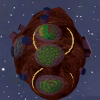-
Posts
196 -
Joined
-
Last visited
wesbruce's Achievements
Newbie (1/14)
36
Reputation
-
 Dinkledash reacted to a post in a topic:
Ship Designs
Dinkledash reacted to a post in a topic:
Ship Designs
-
I hope you had time to slot some one new and useful in to my slot in the server test. Sorry I got double booked. Moms 80th birthday. It was attend or be lynched! lol And I was the only one organised enough to have a pen for signing birthday cards.
-

Will we be able to build ships or space stations with abnormal shapes?
wesbruce replied to Malice1's topic in Builder Forum
Mine will be a flying hobbit house so it blends in to the terrain when landed. -
I said No because there are some contexts where that would render a project impossible. However I have already suggested way to package raw materials as generic cargo that pays people on delivery only, so the courier cannot steal it profitably but anyone stealing it from him still has to deliver it to the designated destination to collect any loot.
-

Any Aussies / Kiwis (or similar timezone people) here?
wesbruce replied to Volkier's topic in Org Updates & Announcements
Yep I'm in Canberra. -

I really want to believe in this but ... really, this doesn't add up!
wesbruce replied to war's topic in General Discussions
That's not how you save a voxel construct. The simplest way is to save the voxel type and number. log the position of the constructs and the important voxels. Mesh over the majority non air voxels to get the surface mesh, Whats visible. That's the first thing you see from a distance. Lod reduces that further. You do not need to record the location of all air voxels unless the air voxels are a small minority. Likewise if the construct is mostly rock you don't need to log the location of every voxel of rock just everything else that is not air and rock. The size of the save will depend on the diversity of the voxel type and complexity available. Another compression trick is to take a cross section though the ship. Compare that to several other adjacent cross sections; If they are all the same you can log that as a repeating plane and only record the number of repetitions. Then log any exceptions to the rule. Also if the ship is built with a symmetry setting on you only need to record and save one side or quarter and the number of planes and the exceptional asymmetrical objects. Thirdly there is a key compression possible for plumbing and electrical's. Pipes only connect to pipes, power to power so the first level of save only needs to log it as a power/ pipe system without saying which. The engine can work out the type from the connections. -

I really want to believe in this but ... really, this doesn't add up!
wesbruce replied to war's topic in General Discussions
Planet side and H1Z1 use forge light but landmark uses voxel farm. They are trying to merge the two at daybreak but its hard. I also have a copy of voxel farm but it's not the same version. Generally twerks right and TehWardy is out of date. DU and Voxel farm are close but not the same and both are 2 generations beyond the limits set by minecraft almost a decade ago. The limits that TehWardy is talking about are also broken easily by some minecraft modding tools and the newer optimisations. . IE minecraft bakes the top surface of a chunk in some mods. World gen is three things. The seed, the biome library, and the chunk system. All major voxel worlds use these, and all bake a set of mesh's at the surface. One serves as collision, one occlusion, there are lighting and in some games, placement meshes, pathing meshes, hazard maps,etc. What you see is created by a lot of things that your computer sees but never draws for you. The next stages of voxel evolution will involve: Localised seeds. I.E. a different seed for part of a planet to the other. Send 3 to 5 continental 'plate' seeds per planet. Giving more diversity than a single seed planet can do. Reversing the seed. Taking the player builds in and area and reversing the seed algorithms or searching seed algorithms and seeds for a close match too them saving the seed and any voxels that differ from that reversed seed. Both humans and computers are only pseudo-random. Hashing a build. Getting a hash does not save the detail of the build, it's a lossy compression, but it may allow some long term saving off line or client side of a build detail with only the hash stored centrally on a server or in a blockchain to prevent tampering and ascertain value in the case of compensating a build error. Comparing two hashes verifies that the data is the same or has changed since two hashes of identical data are always identical. A 100 kilometer world is not a big file. Vladimir Romanyuk's Space Engine stores the entire known universe with to scale planets, Galaxies, asteroids, comets, nebula using a few public databases and some nice world generation code. It is not a game yet that's planned. However you can fly around the universe in ships already. -
 ForlornFoe reacted to a post in a topic:
Ship Designs
ForlornFoe reacted to a post in a topic:
Ship Designs
-
We will be mining long before we are flying so I'll be doing something like the traveller RPG.
-

Is there an actual lore link to whats already been decided?
wesbruce replied to Vandal_Noire's topic in Roleplay & Lore
It may do a tiny bit more damage that a well thrown clod of dirt. There is a trick here: It may be harder to make the nanomorpher do no damage rather than having it do some damage. It also means you can ever be disarmed, that may have some interesting in game effects. Or lots of head shots. -
 wesbruce reacted to a post in a topic:
Territory Tiles -- Topology
wesbruce reacted to a post in a topic:
Territory Tiles -- Topology
-

what kinds of weather if there is any and solar flairs
wesbruce replied to waynethecool's topic in General Discussions
This is the third weather channel on the site. Find the other two for more. lol. Weathers hard to do. -

Another gem from Twitter. A look at Alioth.
wesbruce replied to Hotwingz's topic in General Discussions
I'm calling dibs on the little island on the left! -

City Planners / Urban Planners / Zone Planning
wesbruce replied to juvenius's topic in Builder Forum
Structure cores define a specific volume. Length, breadth, height parameters the cores come in 5 or 6 sizes. Smaller structures may be able to nest in available space in or on the edge of larger structures. Or they may exclude each other. That defines any city geometry. The other factor may be the need for streets, landing pads, parking. We will have people that want to walk, run, use hover vehicles that probably can't go more that 1 or 2 metres high so we will need roads. Landing vertically is hard so many flying craft will need skyways, highways in the sky. Like the jetsons, star wars or 5th element. We may even need speed limits. Horror! The orgs may lay out at the very least flattened terrain, stone roads or marked roads. White engineered stone perhaps. Most will build along them. I've played in a few games where sandbox building occurs; second life, minecraft servers, wurm online. Make a road and you find most people honour and build out from the resulting informal design. We will have shanty towns in some places but even that will be a style choice. One question is what happens to the structures resources when you deactivate a structure core to pack it up and move. Do the resources despawn back to your inventory? If it does then there is no problem. Shanties will clear as people move; structure cores are expensive. If not the resources walls floors etc would be unprotected and would be mined out by either the owner or others. I'm not a dev so I'm just going on the existing published game design. However I'll be making roads where I need to. -
The ship core units come in five sizes with known length, breadth and height. Even if you don't put voxels in that volume that volume defines the ship and it's collusion volume relative to other ships of the same core class and landing on voxels of terrain and larger ships. Thus we can define 4 or 5 door and hatch areas as the front face of the class for doors, or it's bottom face for hatches. I would be possible to add 5 elements for doors and 5 for hatch/elevators which would either spawn the door voxels or would control them. You can do modular voxel doors of any size if you have a voxel that switches both texture and collision category on a signal. The question is whether you want to have that signal sent to all voxels in a volume XYZa to XYZb or propagating though from voxel to voxel. The latter is harder. Animating the texture nor using a large macro texture adds complexity. Ship elevators are also possible if you have a deck walk able voxel and a volume. Any thing in the volume is moved down or up at velocity n with the deck voxel moving with them. You would either need an alignment field that pulls ships of the correct size into alignment. See No mans sky for that. It would bounce bigger ships. Or you would need to make the doors a little larger than needed for bad pilots. Most games do both. Force fields are easier because in most cases they are just no collide voxels with a translucent texture. The minecraft mods are on the curse list and on they're all on github. If you ask permission you may find you could read the code and quickly work out the C++ equivalent. Most static block tricks in minecraft should be doable with Dual Contouring. If it does not have an inventory or flow but just a state and texture swap it should be easy. https://mods.curse.com/mc-mods/minecraft/238546-modular-force-field-systems-mffs
-
Ramming is dead easy in ship combat. Just add a ram weapon that you add to a ship that does a huge amount of damage, adjusted for velocity, but has a 1 or 2 metre range. You automatically tab target any ship in range. The real problem is the gameplay effects it makes big dumb ram ships too easy and kills all other ship combat options.
-
Ramming and easily blowing a hole in a ship is unlikely. Combat will be about knocking out ship systems and finishing with a boarding action and a hack to take the ship. On resource limits a 100 km planet has 125000 cubic kilometres of rock. If it has only 1000 ore seams per km2 that's a lot of ore. So in a couple of years 20000 people will have to dig though every cubic km to find every ore seam. We are not going to find every ore seam. Australia has sites where the gold rush never mined out the ore. Easier and cheap mines were founds and so the miners moved on leaving some ore untouched. One is 40 km from where I live. It was reopened in the 1980's and is still being mined today 20 years later. It should be possible to do planetary restoration on a grand scale. Repairing mined out landscapes can be a simple task if rock, dirt and grass are replaceable without a claim. It's easy to create an org to beautify spawn and repair the world. It's even possible to make a filling voxel cheaply to fill holes. It's a simple matter to make restoration an org project or a Nova Quark market NPC transaction.
-
Mathig your out of date with how voxels work now. You can generate that terrain mesh quite easily in a voxel engine. That's just a voxel terrain, relatively smooth, with decorations; the rocks. I can't see why you think it's a non voxel terrain. There many other worlds: rising world, Landmark, Life is feudal or Wurm online all of which look similar. They have slightly different resolutions. Wurm is the biggest and oldest grading down to landmark which is 20 cm. You can take any terrain mesh and plug it into a voxel engine to get most terrain. Even real world digital elevation meshes can be used. Procedural engines just mix them as grey scale textures beforehand with various weighting algorithms. Voxels don't need to be blocky. Minecraft, blockscape, vox and cube world are blocky as a style. Here is a youtube of me in another voxel world. Rising world. It's not using Dual Contouring and I glitch though the world plane once. It has a lot of grass but it definitely is the kind of thing most voxel engines can do today. DU is doing some innovative things but the basic terrain you see is the easy bit. You can make that terrain in Unity, Blender, etc.







